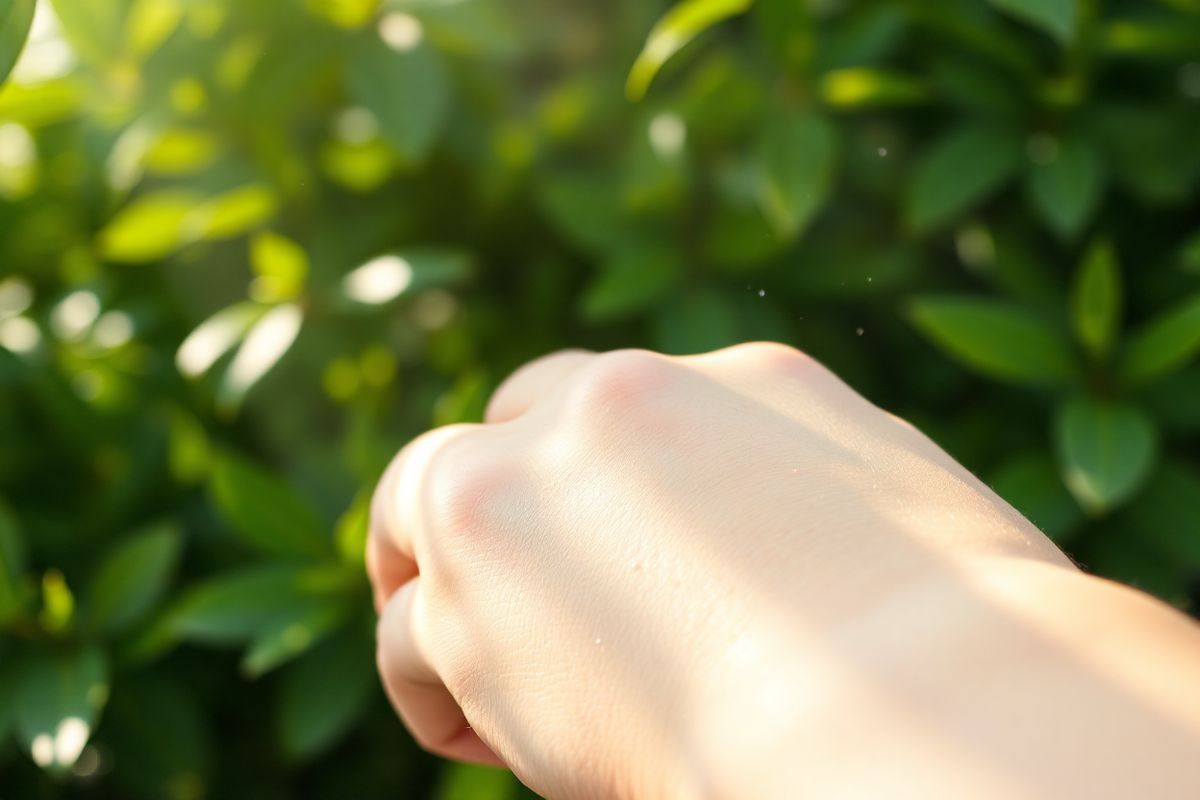Table of Contents
What is Chronic Spontaneous Urticaria and How Does It Affect Patients?

Chronic Spontaneous Urticaria is defined by recurrent episodes of wheals and/or angioedema that occur without an apparent trigger. Unlike acute urticaria, which lasts less than six weeks, CSU can persist for years. The disease is often unpredictable, with patients experiencing flare-ups that can be triggered by factors such as stress, temperature changes, or infections.
The pathophysiology of CSU primarily involves mast cell activation and degranulation, leading to the release of histamine and other inflammatory mediators. This results in increased vascular permeability, causing the hallmark symptoms of wheals and angioedema. Research has shown that CSU may also have an autoimmune component, where the body’s immune system mistakenly targets its tissues, contributing to mast cell hyperactivity (Choi et al., 2024).
Patient experiences vary; some may find their symptoms manageable, while others may have significant impairment in daily activities, sleep quality, and mental health. The condition can also lead to comorbidities such as anxiety and depression, further complicating the management of CSU.
Navigating Diagnosis: Key Steps to Identify CSU Effectively

Diagnosing CSU involves a comprehensive approach that begins with a detailed medical history and physical examination. Key steps in the diagnostic process include:
- Medical History: Understanding the onset, duration, and characteristics of wheals, as well as any accompanying symptoms such as angioedema.
- Physical Examination: Assessing the distribution and morphology of wheals.
- Laboratory Tests: Basic tests such as a complete blood count (CBC), C-reactive protein (CRP), and erythrocyte sedimentation rate (ESR) may be performed to rule out underlying conditions. In some cases, specific tests for autoimmune markers or IgE levels may be conducted (Friedman et al., 2024).
Despite the straightforward diagnostic criteria, many patients report extended wait times for diagnosis, often consulting multiple healthcare providers before receiving a definitive diagnosis (Zuberbier et al., 2022).
Current Treatment Options: A Deep Dive into Antihistamines and Beyond
The cornerstone of CSU management is the use of antihistamines. Second-generation H1-antihistamines (sgAHs) are typically the first-line treatment, providing relief from itching and reducing wheal formation. However, approximately 50% of patients do not achieve adequate symptom control with standard doses of antihistamines. For these patients, higher doses or alternative treatments may be necessary.
Treatment Modalities
- Second-Generation H1-Antihistamines: These medications are preferred due to their lower sedative effects. Common examples include cetirizine, loratadine, and desloratadine.
- Omalizumab: This anti-IgE monoclonal antibody is an option for patients who are antihistamine-resistant. It has shown significant efficacy in reducing urticaria activity scores (UAS) and improving quality of life.
- Dupilumab: A newer treatment targeting IL-4 and IL-13 signaling pathways, dupilumab has shown promise in clinical trials for patients unresponsive to antihistamines (Dupilumab Shows Significant Reductions in Itch and Hive Activity in Patients With CSU, 2024).
TablSummary of Current Treatment Options for CSU
| Treatment | Mechanism | Indication |
|---|---|---|
| Second-Generation H1-Antihistamines | Block H1 receptors to prevent mast cell degranulation | First-line treatment for CSU |
| Omalizumab | Inhibits IgE binding to FcεRI on mast cells | For patients resistant to antihistamines |
| Dupilumab | Blocks IL-4 and IL-13 signaling | For uncontrolled CSU |
The Role of Dupilumab: Efficacy and Safety in CSU Management
Dupilumab is a fully human monoclonal antibody that inhibits the interleukin-4 receptor alpha subunit, impacting both IL-4 and IL-13 signaling pathways, which are critical in the pathogenesis of type 2 inflammation. The LIBERTY-CSU CUPID study demonstrated that dupilumab significantly reduces itch severity and urticaria activity scores in patients with CSU who are refractory to antihistamines (Treating Chronic Spontaneous Urticaria: Findings from the LIBERTY-CSU CUPID Study A, 2024).
Key Findings from the LIBERTY-CSU CUPID Study
- Efficacy: Dupilumab-treated patients showed a greater reduction in itch severity scores compared to placebo, with significant improvements in overall control of urticaria.
- Safety: The safety profile of dupilumab in this study was consistent with previous data, with common adverse effects including injection site reactions and mild respiratory infections. Notably, no cases of conjunctivitis were reported, which is a common concern with this class of medications.
TablSummary of Dupilumab Efficacy in CSU
| Endpoint | Dupilumab Group (%) | Placebo Group (%) |
|---|---|---|
| Achieved UAS7 ≤ 6 | 41 | 23 |
| Achieved UAS7 = 0 | 30 | 18 |
Exploring Future Directions: Innovations in CSU Treatment Strategies
As research continues to evolve, several potential therapeutic options are being investigated for CSU management. These include:
- Platelet-Activating Factor (PAF) Antagonists: Given the role of PAF in mast cell degranulation, targeting this pathway may provide a novel approach for CSU treatment (Role of Platelet-Activating Factor in the Pathogenesis of Chronic Spontaneous Urticaria, 2024).
- Biologics: Beyond dupilumab and omalizumab, other biologics targeting Th2 cytokines and pathways involved in mast cell activation are under exploration.
- Nanoparticle Therapies: Emerging research suggests that nanoparticles may aid in managing chronic wound infections and could be adapted for CSU treatment (How Nanoparticles Help in Combating Chronic Wound Biofilms Infection?, 2024).
FAQ
What is Chronic Spontaneous Urticaria?
Chronic Spontaneous Urticaria is an inflammatory skin condition characterized by the recurrent appearance of itchy wheals and/or angioedema for more than six weeks without identifiable triggers.
How is CSU diagnosed?
CSU is diagnosed through a detailed medical history, physical examination, and sometimes laboratory tests to rule out other conditions and identify any potential autoimmune factors.
What are the standard treatments for CSU?
First-line treatment usually involves second-generation H1-antihistamines. If patients are resistant, options like omalizumab or dupilumab may be considered.
Is dupilumab effective for CSU?
Yes, dupilumab has shown significant efficacy in reducing symptoms and improving quality of life for patients with CSU who are unresponsive to antihistamines.
What are the future treatment strategies for CSU?
Future strategies may include biologics targeting specific inflammatory pathways, PAF antagonists, and potential nanoparticle therapies that have shown promise in other chronic inflammatory conditions.
References
-
Choi, B. Y., Ye, Y. M., & Russo, I. (2024). Role of Platelet-Activating Factor in the Pathogenesis of Chronic Spontaneous Urticaria. International Journal of Molecular Sciences, 25, 12143. https://doi.org/10.3390/ijms252212143
-
Dupilumab Shows Significant Reductions in Itch and Hive Activity in Patients With CSU. (2024). Pharmacy Times
-
Friedman, A., Kwatra, S. G., & Yosipovitch, G. (2024). A Practical Approach to Diagnosing and Managing Chronic Spontaneous Urticaria. Dermatology and Therapy, 14, 1173. https://doi.org/10.1007/s13555-024-01173-5
-
How Nanoparticles Help in Combating Chronic Wound Biofilms Infection? (2024). International Journal of Nanomedicine, 19, 1770. https://doi.org/10.2147/IJN.S484473
-
Treating Chronic Spontaneous Urticaria: Findings from the LIBERTY-CSU CUPID Study A. (2024). Dermatology Times. https://www.dermatologytimes.com/view/treating-chronic-spontaneous-urticaria-findings-from-the-liberty-csu-cupid-study-a
-
Zuberbier, T., et al. (2022). The international EAACI/GA²LEN/EuroGuiDerm/APAAACI guideline for the definition, classification, diagnosis, and management of urticaria. Allergy, 77, 734-766



